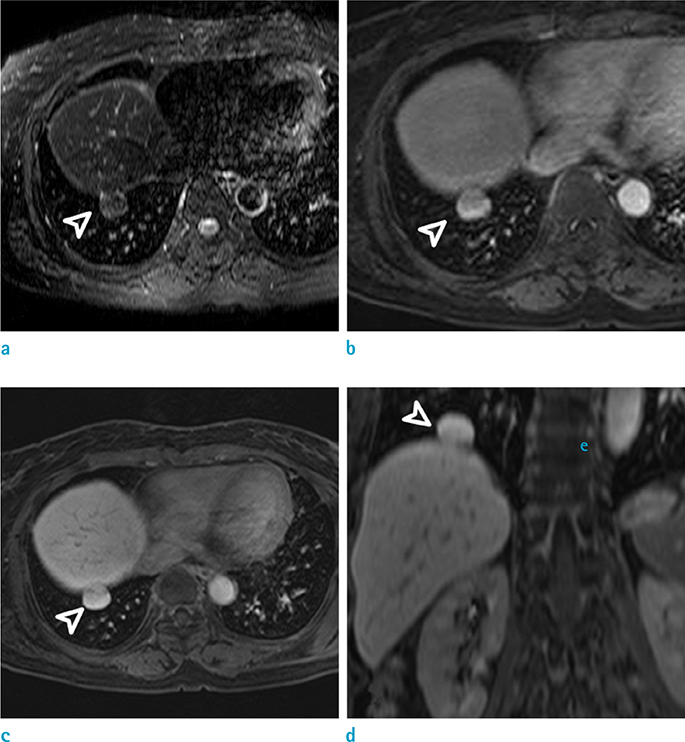Investig Magn Reson Imaging.
2015 Mar;19(1):52-55. 10.13104/imri.2015.19.1.52.
Supradiaphragmatic Liver Confirmed by a Hepatocyte-specific Contrast Agent (Gd-EOB-DTPA): A Case Report
- Affiliations
-
- 1Department of Radiology, Daejin Medical Center Bundang Jesaeng General Hospital, Seongnam-si, Gyeonggi-do, Korea. hyukjungk@naver.com
- KMID: 2175577
- DOI: http://doi.org/10.13104/imri.2015.19.1.52
Abstract
- Supradiaphragmatic liver is a rare condition. Establishing an accurate preoperative diagnosis is difficult. Operative exploration is necessary to differentiate this lesion from intrathoracic masses, such as a pleural based tumor, diaphragmatic tumor and peripheral lung tumor. However, with the aid of the hepatocyte-specific magnetic resonance imaging contrast agent, gadoxetic acid (Gd-EOB-DTPA), functional hepatocytes in the lesion can be identified in the hepatobiliary phase, potentially allowing an accurate and non-invasive diagnosis. We report a case of supradiaphragmatic liver diagnosed by Gd-EOB-DTPA-enhanced magnetic resonance imaging.
Keyword
Figure
Reference
-
1. Choi SU, Kim HK, Kim J. Heterotopic supradiaphragmatic liver combined with intralobar pulmonary sequestration. Ann Thorac Surg. 2008; 85:1809–1810.2. Chen YY, Huang TW, Chang H, Hsu HH, Lee SC. Intrathoracic caudate lobe of the liver: a case report and literature review. World J Gastroenterol. 2014; 20:5147–5152.3. An J, Han J, Lee KS, Choi YS. Supradiaphragmatic heterotopic liver presenting as a pleural mass: a case report. Tuberc Respir Dis. 2010; 69:191–195.4. Kurt A, Yazıcıoğlu KR, Tosun Ö, Coşkun M. Right sided diaphragmatic hernia in an adult without history of trauma: Unusual CT findings. Eur J Gen Med. 2004; 1:55–57.5. Mendoza A, Voland J, Wolf P, Benirschke K. Supradiaphragmatic liver in the lung. Arch Pathol Lab Med. 1986; 110:1085–1086.6. Agha FP. Transdiaphragmatic liver hernia in adults. Australas Radiol. 1985; 29:19–25.7. Sato K, Orihashi K, Hamanaka Y, et al. Post-traumatic diaphragmatic herniation of the liver, examined by positron emission tomography: case report. World J Emerg Surg. 2011; 6:30.8. Luoma R, Raboei E. Supradiaphragmatic accessory liver: a rare cause of respiratory distress in a neonate. J Pediatr Surg. 2003; 38:1413–1414.9. Kinnunen P, Kulmala P, Kaarteenaho-Wiik R, Vuopala K. Ectopic liver in the human pericardium. Histopathology. 1997; 30:277–279.
- Full Text Links
- Actions
-
Cited
- CITED
-
- Close
- Share
- Similar articles
-
- Hepatic Lymphoma Representing Iso-Signal Intensity on Hepatobiliary Phase, in Gd-EOB-DTPA-Enhanced MRI: Case Report
- Enhancement Pattern of Liver Parenchyma during Late Dynamic Phase Imaging: Comparison between Gd-EOB-DTPA and Gd-DTPA-BMA
- MR study of water exchange and cell membrane permeability in rat liver cells using a tissue-specific MR contrast agent
- Quantitative Evaluation of the Hepatic Parenchymal Change in Patients with Chronic Liver Disease Using Gd-EOB-DTPA-enhanced MRI: Comparison with Normal Liver
- Confident Diagnosis of Bronchobiliary Fistula Using Contrast-Enhanced Magnetic Resonance Cholangiography



